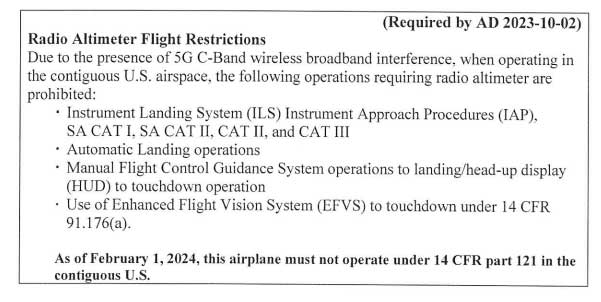 Recently there have been many questions regarding potential 5G interference with Aircraft Radio Altimeter (Rad Alt) Systems by our technicians and customers. The FAA released AD 2023-10-02, which explains this situation and how to proceed. Duncan Aviation’s Avionics Tech Rep team would like to clarify this AD and keep you up to date on the current situation.
Recently there have been many questions regarding potential 5G interference with Aircraft Radio Altimeter (Rad Alt) Systems by our technicians and customers. The FAA released AD 2023-10-02, which explains this situation and how to proceed. Duncan Aviation’s Avionics Tech Rep team would like to clarify this AD and keep you up to date on the current situation.
The AD explains that there are two types of aircraft, “radio altimeter tolerant airplane” and “non-radio altimeter tolerant airplane.” The FAA defines the two as follows:
(1)For purposes of this AD, a “radio altimeter tolerant airplane” is one for which the radio altimeter, as installed, demonstrates the tolerances specified in paragraphs (g)(1)(i) and (ii) of this AD, using a method approved by the FAA. No actions are required by this AD for radio altimeter tolerant airplanes.
(i) Tolerance to radio altimeter interference, for the fundamental emissions (3.7–3.98 GHz), at or above the power spectral density (PSD) curve threshold specified in figure 1 to paragraph (g)(1)(i) of this AD.
(2) For purposes of this AD, a “non-radio altimeter tolerant airplane” is one for which the radio altimeter, as installed, does not demonstrate the tolerances specified in paragraphs (g)(1)(i) and (ii) of this AD.
The AD goes on to say: "some radio altimeters may already demonstrate tolerance to 5G C-Band emissions without modification. Some may need to install filters between the radio altimeter and antenna to increase a radio altimeter's tolerance. For others, the radio altimeter will need to be replaced with an upgraded radio altimeter as established by a new radio altimeter TSO, which will follow the existing international technical consensus on the establishment of the minimum operational performance standards (MOPS). The FAA considers this AD an interim action because additional rulemaking may be necessary once a new radio altimeter TSO is developed, approved, and available."
Therefore, this AD applies to ALL aircraft types that we service at Duncan Aviation. Per the AD, "This AD applies to all transport and commuter category airplanes equipped with a radio (also known as radar) altimeter. These radio altimeters are installed on various transport and commuter category airplanes, including but not limited to, the airplanes for which the design approval holder is identified in paragraphs (c)(1) through (18) of this AD.
"i) AFM Revision After June 30, 2023
For non-radio altimeter tolerant airplanes, do the actions specified in paragraphs (i)(1) and (2) of this AD.
(1) On or before June 30, 2023, revise the Limitations Section of the existing AFM to include the information specified in figure 4 to paragraph (i) of this AD. This may be done by inserting a copy of figure 4 to paragraph (i) of this AD into the existing AFM. Incorporating the AFM revision required by this paragraph terminates the AFM revision required by paragraph (h) of this AD.
(2) Before further flight after incorporating the limitations specified in figure 4 to paragraph (i) of this AD, remove the AFM revision required by paragraph(h) of this AD.
Figure 4 to paragraph (i)— AFM Revision for Non-Radio Altimeter Tolerant Airplanes"

If you have any further questions, please feel free to contact the Duncan Aviation Avionics Tech Rep Group. You may also reference Duncan Aviation’s 5G-Be Prepared landing page at www.DuncanAviation.aero/5G.
Duncan Aviation Avionics Tech Rep Group
 Chris Christianson
Avionics Tech Rep
Astra, Challenger, Citation, Embraer, Falcon, Global, Gulfstream, Hawker, Learjet, Westwind Lincoln, NE (LNK)
+1 402.470.4548
ext. 1441
Chris Christianson
Avionics Tech Rep
Astra, Challenger, Citation, Embraer, Falcon, Global, Gulfstream, Hawker, Learjet, Westwind Lincoln, NE (LNK)
+1 402.470.4548
ext. 1441
December 2025
December 2025
November 2025
October 2025
October 2025